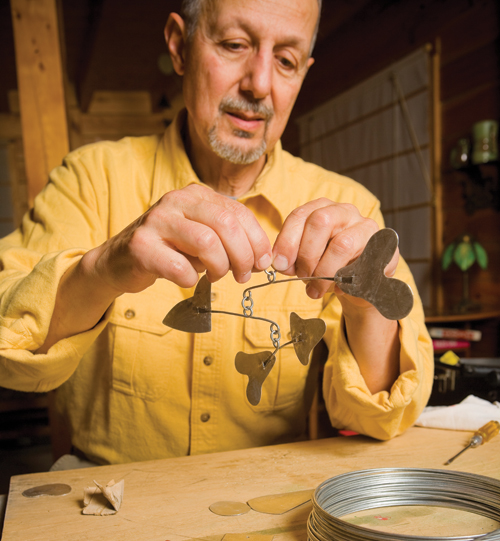
Sculptor Santo Mirabile works on a mobile in his studio. (Photography by John Stranovsky)
Written By Kimberly Liddick-Byrnes
When he is creating, he works in complete silence, almost in a meditative state. He turns the sunroom overlooking some woods in Union Bridge into his work area. As he cuts the metal pieces and adds color to bring them to life, he is focused on one thing: balance. Above all else in this work, Santo Mirabile must consider balance.
“The real truth of a mobile is that physical truth creates visual truth,” he said. “Its function makes it beautiful because of balance.”
Mirabile, 66, is an artist who has found success in many creative areas, not only painting and graphic design, but in sculpture and music as well. His latest interest has been in building mobiles, which he says he finds fascinating because they are alive, involving motion, air flow and three-dimensional composition.
Santo is a family name, part of a Sicilian tradition carried from Italy two generations back. His last name means “marvelous” or “wonderful” in Latin. Music was his first love. He was introduced to music when he contracted polio as a child. He was bedridden, he said, for the better part of five years.
“My parents wanted me to have something to do,” he said, “so they bought me a clarinet.”
While attending Parkville High School, Mirabile learned to play other instruments, including the saxophone, “so I could play rock and roll.”
He got into R&B and eventually auditioned for a national act. After he was chosen to join the group he learned he would be traveling with rhythm and blues legend Patti Labelle.
Mirabile traveled the world for three years with the singer, working as her horn section leader and saxophone, clarinet and flute soloist.
“I left the group because I couldn’t see myself growing old doing that,” he said. “I love the music but I didn’t like the traveling, the grueling schedule, anymore. My parents were smart: They made sure I had a backup.”
The backup was an MFA from the Maryland Institute College of Art, earned before he want on the road with Labelle. He used it, and for several decades worked as a staff artist and graphic designer for various organizations throughout the state, including 10 years as an artist at WJZ television.
He recalls living in an apartment in Bethesda during the Ô70s that had white walls and high ceilings. The artist in him was wondering what to do with that space. At that time he says he was just doodling and doing some drawings. But he had encountered the work of Alexander Calder, the American artist who invented the mobile in the early 1930s.
“Ever since I saw my first Calder mobile it was in my head,” he said. “I had to wait until I retired before I could really explore constructing mobiles myself. My goal has been to use Calder’s technology with my own imagery,” he said.
Mirabile has been building mobiles for more than a year. They are on display at Gallery 50 art studio in Rehoboth Beach, Del. He is thrilled and inspired by the fact that eight of his mobiles have sold for prices ranging from $650 to $2,000.
For the artist, inspiration comes from different places and in different ways. He said that at some point he just sat down and started to draw shapes. He imagines concepts that compel him to pick up pen and paper and sketch.
Working entirely with metal – aluminum or galvanized steel – Mirabile feels that the construction must be mechanically correct. With no formal training in engineering (unlike Calder, who earned a degree in engineering) Mirabile spent months analyzing Calder’s works, trying to figure out how to construct them.
He overcame challenge after challenge, trying to create tools that would allow him to do the same type of work that Calder did, understanding how the paint added weight to the light metal pieces, figuring out how different shapes behaved differently.
“My struggle is to prove to people that you can go beyond what Calder did,” he said. “The art form can evolve, not necessarily to be made better, but as real fine art that is beautiful.
Mobiles should be in big homes with high ceilings. As with other pieces of art, there are considerations that have to be made when placing them, such as how to light them and allowing for the air flow in the area.”
Gallery 50 owner Jay Pastore said that mobiles are definitely a unique form of art.
“No one else in the area is doing anything like Mirabile,” said Pastore. “People have homes with high ceilings and they want to fill that space with art. Mobiles are also very peaceful It’s kind of like having an aquarium, a peaceful movement in the room.”
Balance is important in Mirabile’s mobiles. It is also important in his life. He said that he has never been the “starving artist type.” He wants to live comfortably and have nice things around him, which is why he waited until he retired to embark on this artistic journey. But he does have aspirations for his mobiles.
“I want to get this going so I can build myself a studio,” he said. “Then I can go big. Working big is more comfortable. To me it’s sensual. Mobiles are like an environment. There are no limits to where I can go with this. With painting, I’m locked into four squares of a canvas. I can’t do that anymore; I really need to work in the round.”

